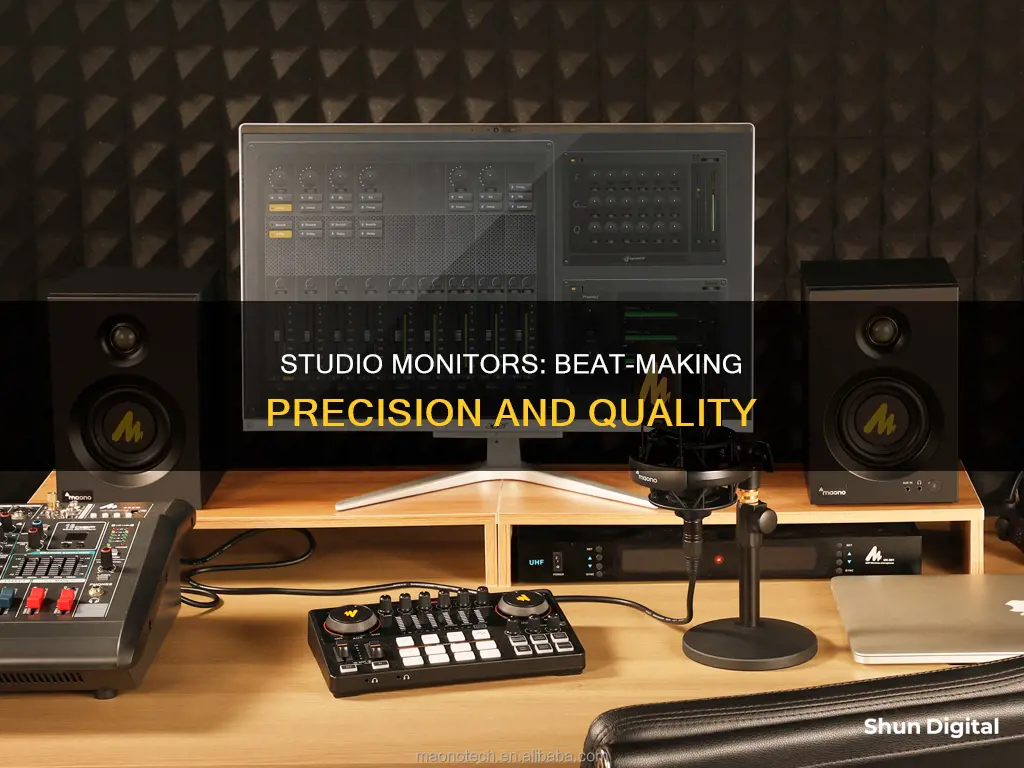
Studio monitors are an essential piece of equipment for beat-making and music production. They are designed to have a flat frequency response, meaning all frequencies are played at the same volume level, resulting in an accurate and unbiased representation of the sound. This feature is crucial for mixing and mastering music to ensure that it sounds good on all playback systems.
When choosing studio monitors, there are several factors to consider, including the type of amplifier (active or passive), the number of speakers (2-way or 3-way design), the amplifier configuration (single-amp, bi-amp, or tri-amp), the size of the monitors and the wattage. The best option for an individual will depend on their budget, the size of their studio space, the genre of music they produce, and their specific needs and preferences.
For beginners, a decent set of studio monitors can be found for around $200-$400. At this price point, the PreSonus Eris E5, Mackie CR5BT, and KRK ROKIT 7 G4 are worth considering. These monitors offer various tuning and connectivity options and are suitable for small studios.
For intermediate users with a budget of $400-$1000, the Adam Audio T5V, Yamaha HS5, and JBL 305P MkII are excellent choices. These monitors provide exceptional sound quality and detailed, transparent audio, making them ideal for mixing and mastering.
For professionals or those with a higher budget, options such as the Adam Audio A4V, Genelec 8351B, and PMC Result6 offer unparalleled performance, accuracy, and flexibility. These high-end monitors are designed to adapt to any environment and provide pristine sound with exceptional stereo imaging.
| Characteristics | Values |
|---|---|
| Purpose | Mixing down tracks, setting up a small home recording environment |
| Importance | Accurate sound reproduction, critical listening, mixing, mastering |
| Price range | $99 - $20,000 |
| Amplification | Active (built-in) or passive (external) |
| Speaker size | 3" - 8" |
| Physical size and weight | Bigger woofers = bigger monitors |
| Watts | Higher watts = higher volume and headroom |
| Frequency response | Average human hearing range: 20Hz-20kHz |
| Budget | Beginners: $100-$400; Intermediate: $400-$1,000; Professionals: $1,000+ |
What You'll Learn

Studio monitors vs regular speakers
Studio monitors and regular speakers may look similar, but they are designed for different purposes and have several technical differences. Studio monitors are designed to be used in recording studios, radio stations, and other professional audio environments, whereas regular speakers, or hi-fi speakers, are designed for entertainment and are commonly used in home and car audio systems.
Studio monitors aim to provide a flat frequency response, meaning all frequencies are played at the same volume level. This is important for accurately balancing the levels of different frequencies in a mix. Regular speakers, on the other hand, are often biased to emphasise certain frequencies, such as adding more bass, in order to make music sound more pleasant and immersive.
In terms of construction, studio monitors tend to be active, meaning they have built-in amplifiers, while hi-fi speakers are generally passive and require an external amplifier. Studio monitors usually have multiple power amplifiers in one unit, allowing for individual power to the woofer, midrange, and tweeter, resulting in a more precise sound.
Studio monitors are designed for critical listening and are meant to sound "bad" in the sense that they allow you to identify and fix sonic imperfections. They are unforgiving when it comes to room placement and have a narrow sweet spot. In contrast, hi-fi speakers are more flexible in terms of room placement and have a larger sweet spot.
When it comes to sound quality, studio monitors offer a flat, precise sound, making them ideal for nearfield use. This means they do not emphasise any particular frequency, providing an accurate impression of the mix. Hi-fi speakers, on the other hand, offer a more pleasant listening experience with frequency enhancement and coloration to make the sound more immersive.
In summary, studio monitors are designed for audio content creation and analytical decision-making during the post-production phase. They provide an accurate and unbiased representation of the sound, allowing for precise mixing and mastering. Regular speakers, on the other hand, are designed for entertainment and are meant to make music sound as pleasant as possible in most listening circumstances. While there may be some overlap in their use, it is generally advisable to choose the right tool for your specific needs.
Monitoring Memory Usage: A Guide for iMac Users
You may want to see also

Active vs passive monitors
When it comes to active vs passive studio monitors, there are several factors to consider. Active monitors have built-in amplifiers, making them simpler to use and set up, as you don't need any additional equipment. They are also designed to be an all-in-one solution, with the built-in amplifiers specifically matched to the monitors for optimal sound quality. This makes active monitors a convenient and reliable choice, and a good option for beginners.
On the other hand, passive monitors require external amplifiers, which offers more flexibility. With passive monitors, you can choose and upgrade your amplifier and monitors separately, allowing for a more gradual and cost-effective progression to higher-quality gear. This makes passive monitors a good choice for those who want more control over their setup and are willing to put in the extra effort.
In terms of sound quality, active monitors often have a flatter frequency response and greater definition, especially in the case of bi-amp and tri-amp configurations. This is because each driver has its own dedicated amplifier, allowing for more precise sound reproduction. However, the quality of the amplifier in active monitors can vary, and poor-quality amplifiers can affect the overall sound.
When deciding between active and passive monitors, it's important to consider your needs, preferences, and budget. Active monitors are usually a good choice for those who want a simple, plug-and-play solution, while passive monitors offer more flexibility and upgrade options. Additionally, the size of the monitors and the room they will be used in should also be considered, as larger monitors may not be suitable for smaller spaces.
Blind Spot Monitor vs Lane Departure Warning: What's the Difference?
You may want to see also

Amplifier configurations
The single-amp configuration is the simplest setup, where a single amplifier powers both the left and right speakers. This setup is rarely used in studio monitors but is common in computer speakers. For more precise control, the bi-amp configuration is often used in professional studios. In this setup, each driver in a 2-way speaker design has its own dedicated amplifier channel, allowing for better control over the frequency response and more precise sound reproduction. While some 3-way speakers integrate two amplifier channels, the tri-amp configuration takes it a step further by providing a dedicated amplifier channel for each driver in a 3-way speaker system, resulting in the ultimate control over frequency response and sound reproduction. This setup is typically used in high-end professional studios.
When choosing an amplifier configuration, it is essential to consider the level of precision and control needed for your specific application. For most home studios, a bi-amp configuration offers a good balance between precision and affordability. However, for professional studios requiring the highest level of accuracy, the tri-amp configuration is the best option.
Monitoring SAN Performance: Best Practices for Storage Area Networks
You may want to see also

Monitor size
The size of your studio monitor is an important consideration when building your studio setup. The size of the woofer, or low-frequency driver, is usually what is being referred to when discussing studio monitor size. The size of the woofer will impact the amount of low-end or bass frequencies that can be reproduced by the monitor.
For example, the Yamaha HS5 studio monitor features a 5-inch woofer and can reproduce bass frequencies around 54Hz, whereas the Yamaha HS8 has an 8-inch woofer and can reproduce bass frequencies around 38Hz.
When choosing the size of your studio monitor, you should consider the size of your room, the style of music you are producing, and the amount of low-end frequencies present in your music. For EDM music producers, a larger woofer size is recommended to achieve better low-frequency response. Conversely, smaller woofer sizes may offer better midrange and high-frequency response due to their ability to more accurately reproduce these frequencies.
For home studios, a 5-inch woofer is generally recommended as it is a good fit for smaller rooms. However, if you have a larger room, you may require larger speakers to fill the space with sound. It is important to note that untreated rooms may experience sound issues such as reverb and phase cancellation when using larger monitors. In such cases, it is recommended to use smaller monitors or invest in acoustic treatment for your room.
In addition to room size, your listening distance will also impact the size of the monitor you should choose. Larger monitors can be placed farther away from the listener and tend to have a wider sweet spot. Therefore, if you have a large mixing console or studio desk, a larger monitor may be more suitable.
When choosing the size of your studio monitor, it is important to consider your specific needs and constraints. If you are a beginner, a smaller and more affordable monitor may be a good option, whereas more experienced audio engineers may require more advanced features and larger monitor sizes.
Fixing Android Studio's Missing Monitor Jar Issue
You may want to see also

Monitor wattage
For beginners or those working in small-to-medium-sized rooms, a studio monitor with 50-75 watts per channel is generally sufficient. However, if you're working in a large commercial studio, you may need to consider monitors with higher wattage, such as 100 watts or more per channel. It's worth noting that quality is more important than wattage; a well-designed, high-quality studio monitor with lower wattage can often outperform a cheaper monitor with higher wattage.
When testing monitors, it's important to consider the room acoustics and ensure that the monitors can deliver accurate sound reproduction without distortion. The size of the studio also plays a role in determining the required wattage. As a general rule, 50 watts is a good starting point for a home studio.
Additionally, the type of music you produce can influence your choice of wattage. For example, if you're creating bass-heavy music, you may need monitors with higher wattage to handle the low-end frequencies effectively.
Uncover Hidden Internet Monitors: A Comprehensive Guide
You may want to see also
Frequently asked questions
Studio monitors are designed to have a flat frequency response, meaning all frequencies are played at the same volume level. This is crucial when mixing as it allows you to accurately balance the levels of different frequencies in the audio.
Some good budget options for studio monitors include the PreSonus Eris E5, Mackie CR5BT, and KRK ROKIT 7 G4.
Some good premium options for studio monitors include the ADAM Audio A7X, Neumann KH 120, and Genelec 8351B.
When choosing studio monitors, it is important to consider the size of the room, the type of music you will be making, the amplifier configuration, and your budget.







